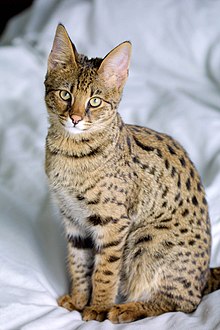Savannah cat
| Savannah | |
|---|---|
 |
|
| Origin | United States |
| Breed standards | |
| CFA | [of america standard] |
| TICA | standard |
| Notes | |
|
Savannahs are about the size of a small dog
|
|
| Feline hybrid (Felis catus × Leptailurus serval) | |
The Savannah is a hybrid cat breed. It is a cross between a serval and a domestic cat.
A Savannah cat is a cross between a domestic cat and the serval, a medium-sized, large-eared wild African cat. The unusual cross became popular among breeders at the end of the 1990s, and in 2001 the International Cat Association accepted it as a new registered breed. In May 2012, TICA accepted it as a championship breed.
A Bengal breeder, Judee Frank, crossbred a male serval, belonging to Suzi Woods, with a Siamese (domestic cat) to produce the first Savannah cat (named Savannah) on April 7, 1986. In 1996, Patrick Kelley and Joyce Sroufe wrote the original version of the Savannah breed standard and presented it to the board of The International Cat Association. In 2001, the board accepted the breed for registration.
The Savannahs' tall and slim build gives them the appearance of greater size than their actual weight. Size is very dependent on generation and sex, with F1 hybrid male cats usually being the largest.
F1 and F2 generations are usually the largest, due to the stronger genetic influence of the African serval ancestor. As with other hybrid cats such as the Chausie and Bengal cat, most first generation cats will possess many or all of the serval's exotic looking traits, while these traits often diminish in later generations. Male Savannahs tend to be larger than females.
Early-generation Savannahs can weigh 8–20 pounds (3.6–9.1 kg), with the most weight usually attributed to the F1 or F2 neutered males due to genetics. Later-generation Savannahs are usually between 7–15 pounds (3.2–6.8 kg). Because of the random factors in Savannah genetics, size can vary significantly, even in one litter.
The coat of a Savannah should have a spotted pattern, the only pattern accepted by the TICA breed standard. The spotted pattern is the only accepted pattern because it is the only pattern found on the African Serval Cat. Non-standard patterns & colors include: Rosetted, marble, snow color (point), blue color, cinnamon color, chocolate color, lilac (lavender) and other diluted colors derived from domestic sources of cat coat genetics. These nonstandard colors should be placed as pets only to be culled out of the gene pool.
...
Wikipedia
